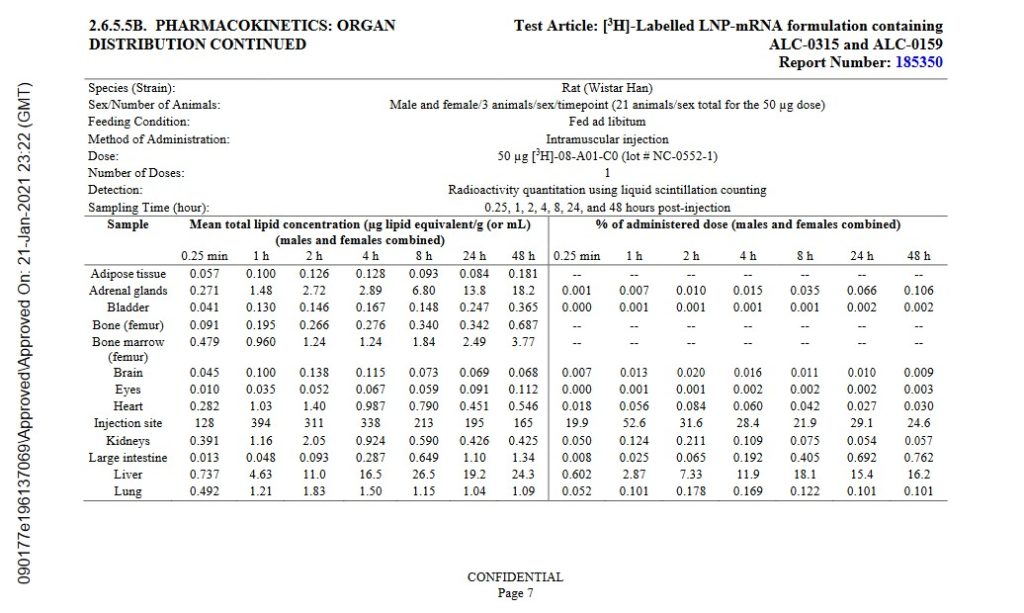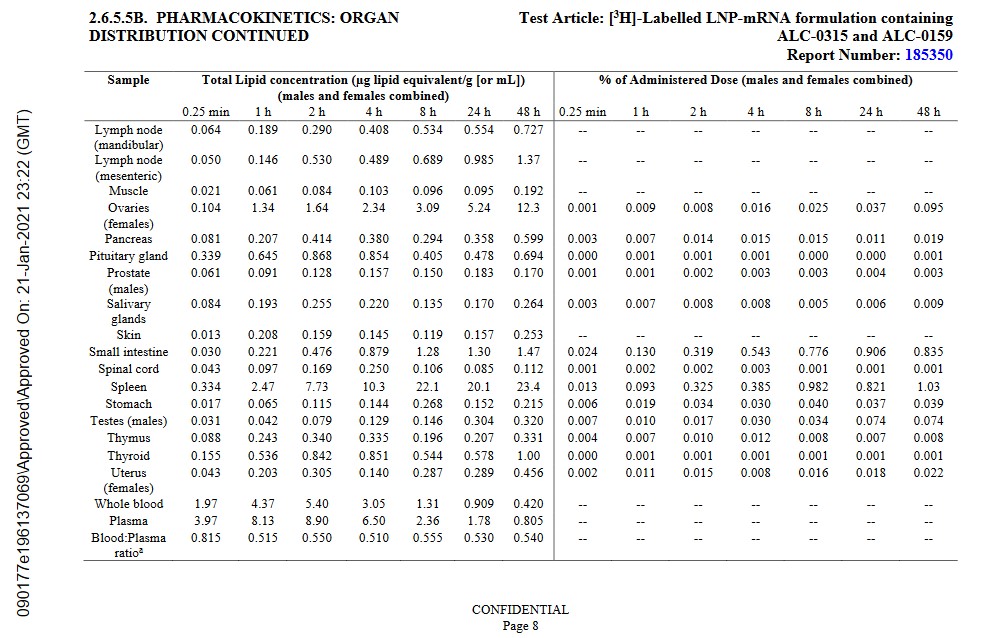What is it that feeds our battle, yet starves our victory?
Blast from the Past
I reached voting age just after the election of 1980.
This was the time when America was humiliated by the Iranian hostage crisis. The Soviet Union was rampaging throughout the third world and was currently involved in Afghanistan despite our protests. The economy was on the ropes, with double digit unemployment and inflation that briefly reached 18 percent (and that’s the official number…no doubt it was actually worse). The then-president even used the word “malaise.”
Then we beat the Soviet Union in a hockey game.
That sounds trivial, doesn’t it? A frigging hockey game.
But the symbolic value was tremendous. It was a win after a long string of losses…and it ended up being a turning point.
We elected a new president, who didn’t have to do anything at all to resolve that damned hostage crisis. Iran released them on Inauguration Day.
And then there was this song…which expressed the sentiment very well (and doesn’t get played nearly as much as another popular song from back then by the same group does now).
America was on the move again.
Today is the 2nd. On the 5th…we will see what happens. Regardless of the result, it’s going to be rough, either because we lost and we’re done, or because we won and it’s being stolen, in which case if 2020 is any guide, we’re done, or because we won outright, and the Enemy is not going to go down without a lot of ugliness…maybe even kinetic ugliness.
Keep your powder dry. If things go well, this is the turnaround point.
January 6 Tapes?
Where are the tapes? Anyone, Anyone? Bueller? Johnson??
Paging Speaker Johnson…this is your conscience calling you out on broken promises.
News Flash
Today, it is still the case that Joe Biden didn’t Win.
I realize that to some readers, this might be a shock; surely at some point things must change and Biden will have actually won.
But the past cannot actually be changed.
It will always and forever be the case that Joe Biden didn’t win.
And if you, Leftist Lurker, want to dismiss it as dead white cis-male logic…well, you can call it what you want, but then please just go fuck off. No one here buys that bullshit–logic is logic and facts are facts regardless of skin color–and if you gave it a moment’s rational thought, you wouldn’t either. Of course your worthless education never included being able to actually reason–or detect problems with false reasoning–so I don’t imagine you’ll actually wake up as opposed to being woke.
As Ayn Rand would sometimes point out: Yes, you are free to evade reality. What you cannot do is evade the consequences of evading reality. Or to put it concretely: You can ignore the Mack truck bearing down on you as you play in the middle of the street, you won’t be able to ignore the consequences of ignoring the Mack truck.
And Ayn Rand also pointed out that existence (i.e., the sum total of everything that exists) precedes consciousness–our consciousnesses are a part of existence, not outside of it–therefore reality cannot be a “social construct” as so many of you fucked-up-in-the-head people seem to think.
So much for Leftist douchebag lurkers. For the rest of you, the regular readers and those lurkers who understand such things: I continue to carry the banner once also carried by Wheatie. His Fraudulency didn’t win.
Let’s Go, Brandon!!
His Fraudulency
Joe Biteme, properly styled His Fraudulency, continues to infest the White House, we haven’t heard much from the person who should have been declared the victor, and hopium is still being dispensed even as our military appears to have joined the political establishment in knuckling under to the fraud.
One can hope that all is not as it seems.
I’d love to feast on that crow.
(I’d like to add, I find it entirely plausible, even likely, that His Fraudulency is also His Figureheadedness. (Apparently that wasn’t a word; it got a red underline. Well it is now.) Where I differ with the hopium addicts is on the subject of who is really in charge. It ain’t anyone we like.)
Justice Must Be Done.
The prior election must be acknowledged as fraudulent, and steps must be taken to prosecute the fraudsters and restore integrity to the system.
Nothing else matters at this point. Talking about trying again in 2024 is hopeless otherwise. Which is not to say one must never talk about this, but rather that one must account for this in ones planning; if fixing the fraud is not part of the plan, you have no plan.
Lawyer Appeasement Section
OK now for the fine print.
This is the WQTH Daily Thread. You know the drill. There’s no Poltical correctness, but civility is a requirement. There are Important Guidelines, here, with an addendum on 20191110.
We have a new board – called The U Tree – where people can take each other to the woodshed without fear of censorship or moderation.
And remember Wheatie’s Rules:
1. No food fights
2. No running with scissors.
3. If you bring snacks, bring enough for everyone.
4. Zeroth rule of gun safety: Don’t let the government get your guns.
5. Rule one of gun safety: The gun is always loaded.
5a. If you actually want the gun to be loaded, like because you’re checking out a bump in the night, then it’s empty.
6. Rule two of gun safety: Never point the gun at anything you’re not willing to destroy.
7. Rule three: Keep your finger off the trigger until ready to fire.
8. Rule the fourth: Be sure of your target and what is behind it.
(Hmm a few extras seem to have crept in.)
Spot Prices.
Kitco Ask. Last week:
Gold $2,748.70
Silver $33.77
Platinum $1033.00
Palladium $1219.00
Rhodium $4,950.00
FRNSI* 131.968+
Gold:Silver 81.395-
This week, markets closed as of 3PM MT.
Gold $2,736.50
Silver $32.51
Platinum $1,002.00
Palladium $1,124.00
Rhodium $4,950.00
FRNSI* 131.378+
Gold:Silver 84.174+
Gold touched $2790 on Wednesday, then suffered an extreme beatdown on Thursday. It looked like it might actually recover a bit on Friday but dropped at the end of the day for a net loss. Similar things happened to silver, but it was worse, it dropped much more, in percentage terms, than did gold and Gold:Silver went right back up into 84 territory. The worst beating in percentage terms was palladium…and I tend to think that’s a bad sign; it’s the metal most closely associated with catalytic converters, hence the car industry. However, palladium has a very variable supply, so it could just be it’s slightly more of a glut on the market than it was last week.
*The SteveInCO Federal Reserve Note Suckage Index (FRNSI) is a measure of how much the dollar has inflated. It’s the ratio of the current price of gold, to the number of dollars an ounce of fine gold made up when the dollar was defined as 25.8 grains of 0.900 gold. That worked out to an ounce being $20.67+71/387 of a cent. (Note gold wasn’t worth this much back then, thus much gold was $20.67 71/387ths. It’s a subtle distinction. One ounce of gold wasn’t worth $20.67 back then, it was $20.67.) Once this ratio is computed, 1 is subtracted from it so that the number is zero when the dollar is at its proper value, indicating zero suckage.
Piling On / Security Alert
OK, how can I pile onto the Flat Earthers and pass on a security alert at the same time, you ask?
Well, because Flat Earth Dave sells an app. For three bucks you get a flat earth clock and can also connect with other Flerfers.
This app has come under scrutiny. And it turns out that Flat Earth Dave doxxed all of his customers.
But before we get to that, a code analysis reveals that the app computes the distance between customers (to help them connect with other flerfers), using the “haversine formula” which is how you compute distances along great circle arcs on a sphere given the two points’ latitude and longitude. In other words Flat Earth Dave’s own code assumes a spherical Earth! (Almost as if he knows something he’s not saying…)
[If you’re curious, it’s 
But we already know Flat Earth Dave is a scum-sucking liar and a hypocrite, because after years of saying he’d love to go to Antarctica to show the sun sets there during Antarctic summer…he turned down the opportunity to do so…clearly knowing he’d be proven wrong but as long as he doesn’t go on the trip he can try to tapdance around the fact that he’s full of shit and knows he’s full of shit.
The bigger issue here is that it’s pretty easy for a hacker to query the app’s server database without even logging in to the app. So they can get hold of everyone’s location, name, and password. (The password is stored in the clear, which is something any computer professional knows not to do. This is the computer science equivalent of shooting yourself in the foot or poking out your own eyeball with a soup spoon.) So if you bought the app and logged in, whatever password you used on that app…which hopefully isn’t the same as a password you use anywhere else, like (say) your online banking or even worse your email…has been compromised.
So if you trusted Flat Earth Dave, you’ve been conned and doxxed. And you won’t be getting your three bucks back (nor the $11/year if you subscribed). Have a nice day.
A different treatment of the same topic, combined with some debunks. A bit long so I certainly wouldn’t expect you to watch it.
Saturn’s Other Moons

Titan, covered last week, is by far the largest of Saturn’s moons. The other 145 (!) moons put together–plus all of the matter in the rings–don’t have even 5 percent of the mass of Titan.
Size notwithstanding much of interest here. With Saturn we encounter our first medium-sized major moons, there are nine in the Solar System and Saturn has four of them. They are (in order from Saturn outwards): Tethys, Dione, Rhea (closer than Titan) and Iapetus (beyond Titan). All have diameters of over 1000 kilometers. All except Iapetus orbit closer to Saturn than Titan. In addition to that, there are two of the medium-small major moons as well, Mimas and Enceladus (both are closer than Tethys) and one comparably sized moon that is not major (meaning, it isn’t round), Hyperion (between Titan and Iapetus). We’ll cover each of these seven moons in detail further down.
(If nothing else, after working on this post for a few days I now have the order of the big eight moons from Saturn outwards, memorized.)
If you remember Saturn once having nine moons (possibly from school in the 1960s) the ones I just mentioned are eight of those nine, with the other one being Phoebe…which is in a totally different class, and much further away than the other eight. I’ll say a bit about that one too. (I’m not quite that old, but a lot of stuff I did see in school in the 1970s was out of date and said “nine.”)
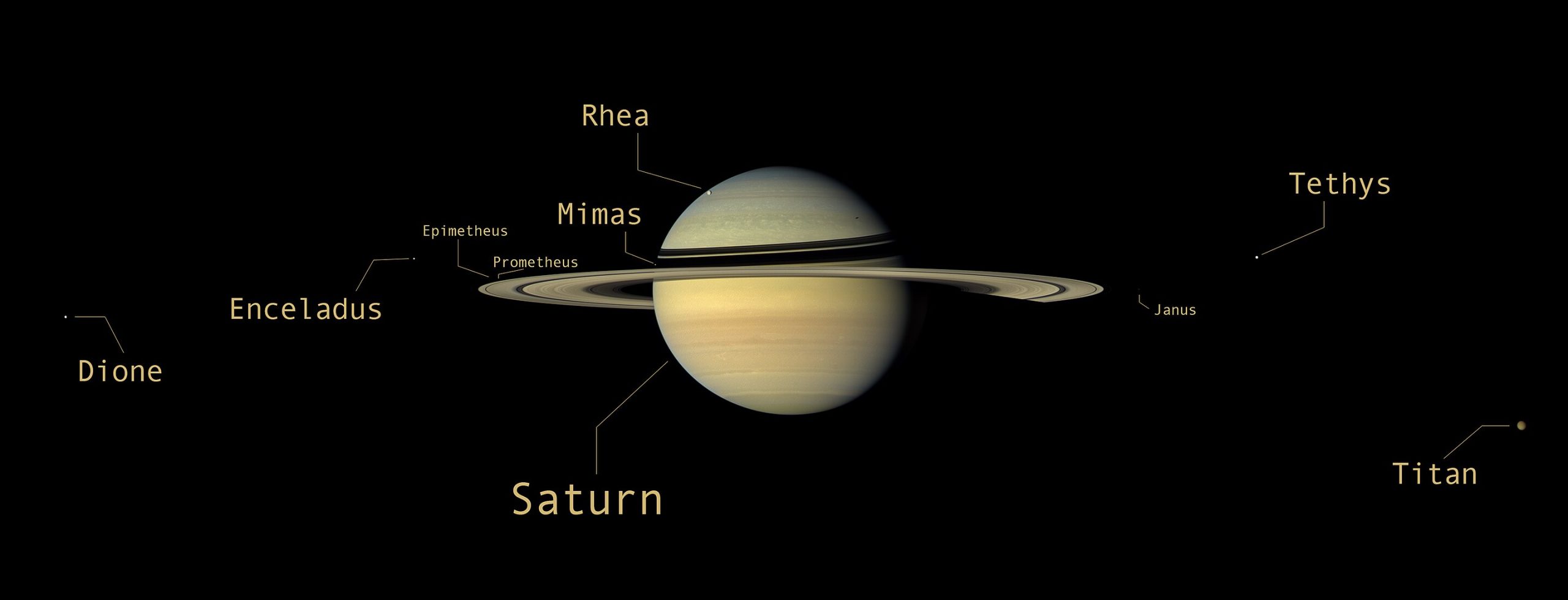
Hyperion, Iapetus and Phoebe are not in this picture, but three of the close-in minor moons (Epimetheus, Janus and Prometheus) shown.
But Saturn has a host of other much smaller moons, too, and in many cases they’re interesting because of their interactions with the rings.
Twenty four of the moons are regular, meaning: They orbit in or near Saturn’s equatorial plane in prograde orbits–the one exception to that is Iapetus, considered regular even though it has a fairly high inclination of 7.57 degrees. Every one of the moons (except Phoebe) I just mentioned are regular moons.
The other 122 moons are all irregular, generally small and insignificant, similar to the mess we had at Jupiter. Saturn has more stuff close to the planet than Jupiter does, but fewer “big categories” overall. There’s also a major distinction here between “Inner” and “Outer” moons; inner moons are either inside the very tenuous E Ring, or actually within it. What’s the E Ring? I’ll discuss it some below, but here’s a reminder:
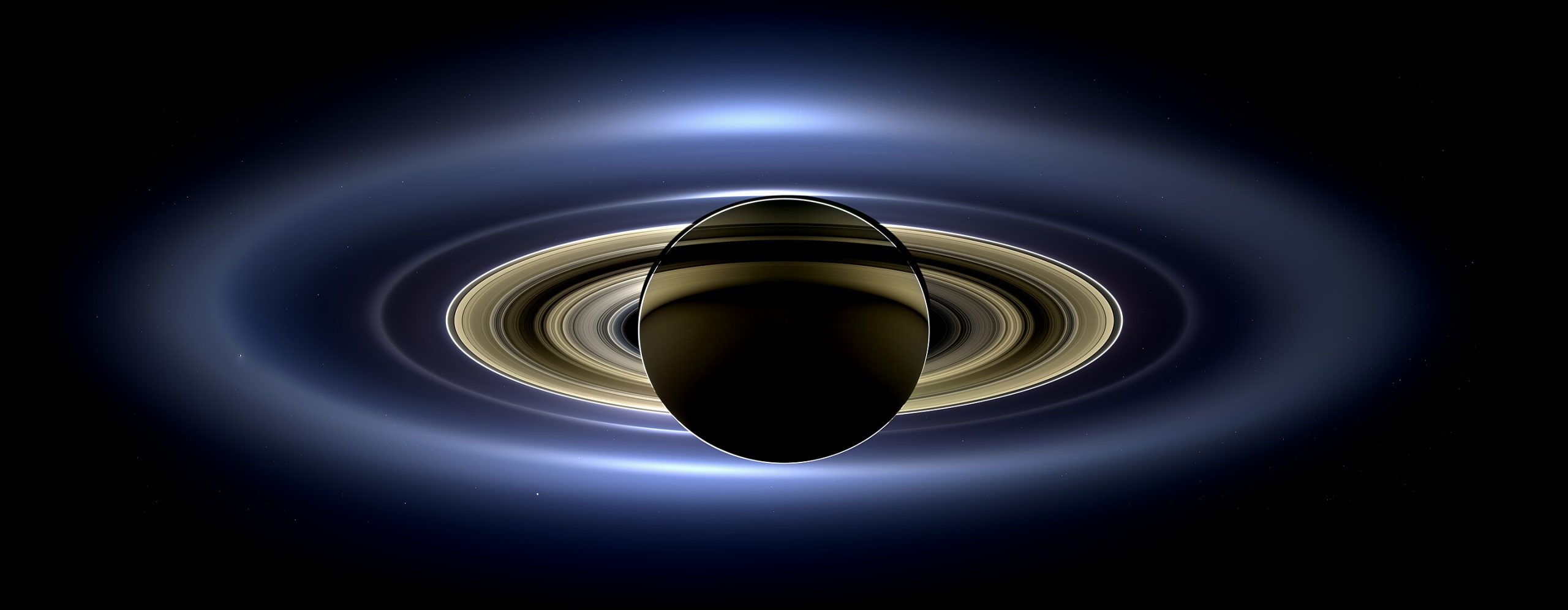
Inner Moons (Inside or Within the E Ring)
Ring Moonlets actually orbit within the Rings. They’re significantly larger than the average, run-of-the-mill ring chunk, but none are of significant size. They are interesting, though because of their interactions with the rings. All are regular, which makes sense because they actually orbit within the “big” rings. Only one has an official number (S/2009 S-1); it’s about 300 m across. Others get down as low as 40 m across, and are not part of the total count.
Ring Shepherds can either be within the rings, or just barely outside of them, and they either keep the ring particles from leaving the rings, or causing gaps to form within the rings. There are four of these, with the most famous being Pan, about 27 km across, which looks like a ravioli. The others are Daphnis, Atlas, and Prometheus.
There are four other small moons well outside the rings, but still pretty close to them in the grand scheme of things. One of these is the tenth moon I knew about as a kid, but it’s a bit confusing because one astronomer spotted the tenth moon, then another one saw it…but in totally the wrong place in its orbit, which threw doubt onto the original observation (as well as this observation). Eventually we realized that there were two moons, Epimetheus and Janus, in the same orbit but different positions in the orbit, and so they are now regarded as the tenth and eleventh moons of Saturn, respectively. So those books from my childhood were written when we didn’t realize yet that Saturn actually had 11 known moons. The other two in this group are Pandora and Aegaeon.
Then we get to the Inner major moons, the first of which is Mimas which I will discuss below.
There are three small moons orbiting between Mimas and the next major moon; again these are all regular moons, these are the Alkonyides group.
Next are more major moons, Enceladus, Tethys and Dione. I’ll discuss each one in detail below.
Tethys and Dione both have two Trojan moons (sharing the same orbit but sixty degrees away from their bigger companion); a bit more on that below too. So far the only moons anywhere in the solar system known to have Trojans are these two.
So far: four major moons (two medium size, two medium-small), one dinky moon with only a number, the four shepherds and four close-in moons, the three Alkonyides, the four Trojans, total 20. All are regular moons, which means there are four remaining regular moons and all 122 irregular moons to go.
Outer Moons (Outside the E Ring)
Outer Big: Rhea, Titan, Hyperion and Iapetus. (All of these will be covered in some detail below.) Were it not for Hyperion, which is not a major moon, just kind of big but lumpy, these could be called the outer major moons. All are regular, even Iapetus with its significant orbital inclination. [Note: Wikipedia calls these the Outer Large moons, but I don’t want to confuse that use of the word “large” with the way I’ve been using it to denote the planetary-sized moons of the solar system.]
And with the last four regular moons checked off, we have nothing left but the entire list of 122 irregular moons. They’re considered irregular because of their eccentric, inclined orbits. These can be broken down into four groups with similar orbits, the Inuit group (13) inclined at about 47 degrees, the Gallic group (7) inclined at about 35-40 degrees, the Norse group (100, including Phoebe) which are all retrograde with inclinations about 170 degrees), then two more “miscellaneous” moons that are prograde. As with Jupiter, it’s likely each of these groups has some sort of common origin (but separate from the other groups). Also the names of the groups indicate the naming convention, with the Norse group named after Norse gods…except for Phoebe which was discovered long before the others were, there was no hint until much later that there was a “group” here. (This isn’t the first, nor will it be the last, time that some body that had been known for a while turned out to be the first of a big group of similar objects.)
The overall summary is in this diagram (which you may want to right-click on to give it full-screen in another tab):

The upper stripe is a fairly conventional side view of Saturn including showing the A through E rings, and most of the Inner Moons including the four majors, Mimas, Enceladus, Tethys and Dione (two are medium sized, two are medium-small).
The middle stripe steps out ten times, and Saturn is now shown at a tilt. The four “Outer Big” moons (one actually large, two medium sized, and one medium-small (and not major) are here. Note that Iapetus is not in the same plane as the others. Here you’ll see lines drawn through each of the four moons; these actually denote the range of possible distances for those moons, meaning they’re in moderately elliptical orbits.
The last diagram zooms out ten times again, or 100 times the first, and shows all of the irregular satellites, at their orbital inclinations. The Norse group has a HUGE range of distances from Saturn, indicating they are all in highly elliptical orbits.
The Big Ones
With the big picture out of the way, let’s go back to those Major Moons (plus Hyperion). And I’ll toss in Phoebe as a bonus, because there’s some interesting things about it too. Let’s start with a table. But first, I need to explain a couple of things. The “A” Ring is the outermost readily visible ring. The “E” ring, on the other hand is very tenuous, discovered in 1907 but not confirmed until 1980…and we’ll soon see how it came to be.
| Moon | Distance From Saturn, 1000s of Km; and (in terms of Titan) | Orbital Period, days | Diameter, km | Discovery year and (order) |
| Outer edge of A ring | 136.8 | |||
| Inner edge of E ring | 180.0 | |||
| Mimas | 186.0 (0.152) | 0.942 | 396.4 | 1789 (7) |
| Enceladus | 238.4 (0.195) | 1.370 | 504.2 | 1789 (6) |
| Tethys | 295.0 (0.241) | 1.888 | 1062.2 | 1684 (5) |
| Dione | 377.7 (0.309) | 2.737 | 1122.8 | 1684 (4) |
| Outer edge of E ring | 480.0 | |||
| Rhea | 527.2 (0.431) | 4.518 | 1527.5 | 1672 (3) |
| Titan | 1221.9 (1.000) | 15.945 | 5149.5 | 1655 (1) |
| Hyperion | 1481.5 (1.212) | 21.277 | ~270.0 (not spherical) | 1848 (8) |
| Iapetus | 3561.7 (2.915) | 79.331 | 1468.6 | 1671 (2) |
| Phoebe (Bonus) | 12929.4 (10.581) | 550.3 (retrorgrade) | 213.0 | 1898 (9) |
These moons are all consecutive, with no intervening small stuff, except for the three Alkyonides between Mimas and Enceladus, and the four Trojan moons of Tethys and Dione.
All of these moons, except Hyperion and Phoebe, are tidally locked to Saturn, displaying the same side towards Saturn at all times, like our Moon does to Earth.
Mimas
Cassini discovered Iapetus, Rhea, Dione and Tethys in the mid-late 1600s. He also discovered the Cassini Division between the A (outermost easily visible) and B (inside the A ring, wider but a bit dimmer) rings, plainly visible even in the photograph I supplied above. The Cassini division is about 4800 kilometers across, and it is actually caused by Mimas; anything orbiting in the gap is in a 2:1 resonance with Mimas (meaning: orbiting twice as fast) and the regular pulls by Mimas in the same places tend to nudge particles out of that orbit…hence the gap. However, it’s not completely empty.
Mimas is the seventh largest moon of Saturn; it just barely makes it into the “medium-small” major class. It’s most notable feature is a very large (compared to it) crater, named after Herschel (who discovered Mimas in 1789 and did not try to name it after King George the Turd), that instantly earned it the nickname “Death Star Moon” since Star Wars was a recent memory when the Voyager spacecraft first photographed it. Look, twins separated at birth:

(I was in high school and at least one photograph from a different angle that was published looked distinctly…weapons grade to many of us. However, at roughly 64K surface temperature, it’s colder than a witch’s.)
Since we’ve sent Cassini through the system, we have seen the different moons’ gravity acting on it and can assess the masses of these moons. Sizes can be measured off the photographs (since distance is known). Dividing mass by volume, we can get a good idea of the density of these moons. It turns out that Mimas’ density is 1.15 times that of water, implying it’s mostly ice with some rocks in it. (But remember, at these temperatures, ice itself is as hard as a rock.)
Enceladus
If when you say it, Enceladus comes out something like “enchiladas” you’re doing it wrong. It’s “en-SELL-a-duss.” Like the other major moons, it’s named after a titan from Greek mythology. There was a time when the gods fought the titans (who were the previous generation), this is called the “gigantomachy.” According to the legend, Athena picked up a gigantic rock and dropped it on Enceladus. It didn’t kill him but apparently he couldn’t push it off of him and it’s still there. Every once in a while Enceladus will twitch and there is an earthquake. (To this day the Greeks will reference that in talking about earthquakes.) The rock, by the way, is now Sicily. (I told you it’s still there.)
Enceladus is one of two moons in the solar system that are in the 500-1000 km diameter range…and it just barely makes it at 504 km. (The other is Dysnomia, estimated to be about 615k km across, which orbits the dwarf planet Eris. We can’t determine if Dysnomia is rounded or not–it’s very hard to see because it is so dark but it’s got a low enough density that it might not have strong enough gravity to crush itself into a spherical shape. And I missed this one when I first did my Moon Roundup–which I have since edited to reflect the fact that Dysnomia exists.)
Enceladus is the most reflective object in the solar system, it’s blast white. Which means it’s clean, which means fresh. And in fact, Enceladus has volcanoes on it, clustered near its south pole, that regularly renew the surface. But unlike the ones on Jupiter’s inner major moon Io, these erupt water.

That is not a black and white photograph (nor will other moons be shown in black and white), It’s just that these moons are neutrally colored. As such people will try to punch it up a bit. So, seen almost as often as that picture is a false-color image, like this one:
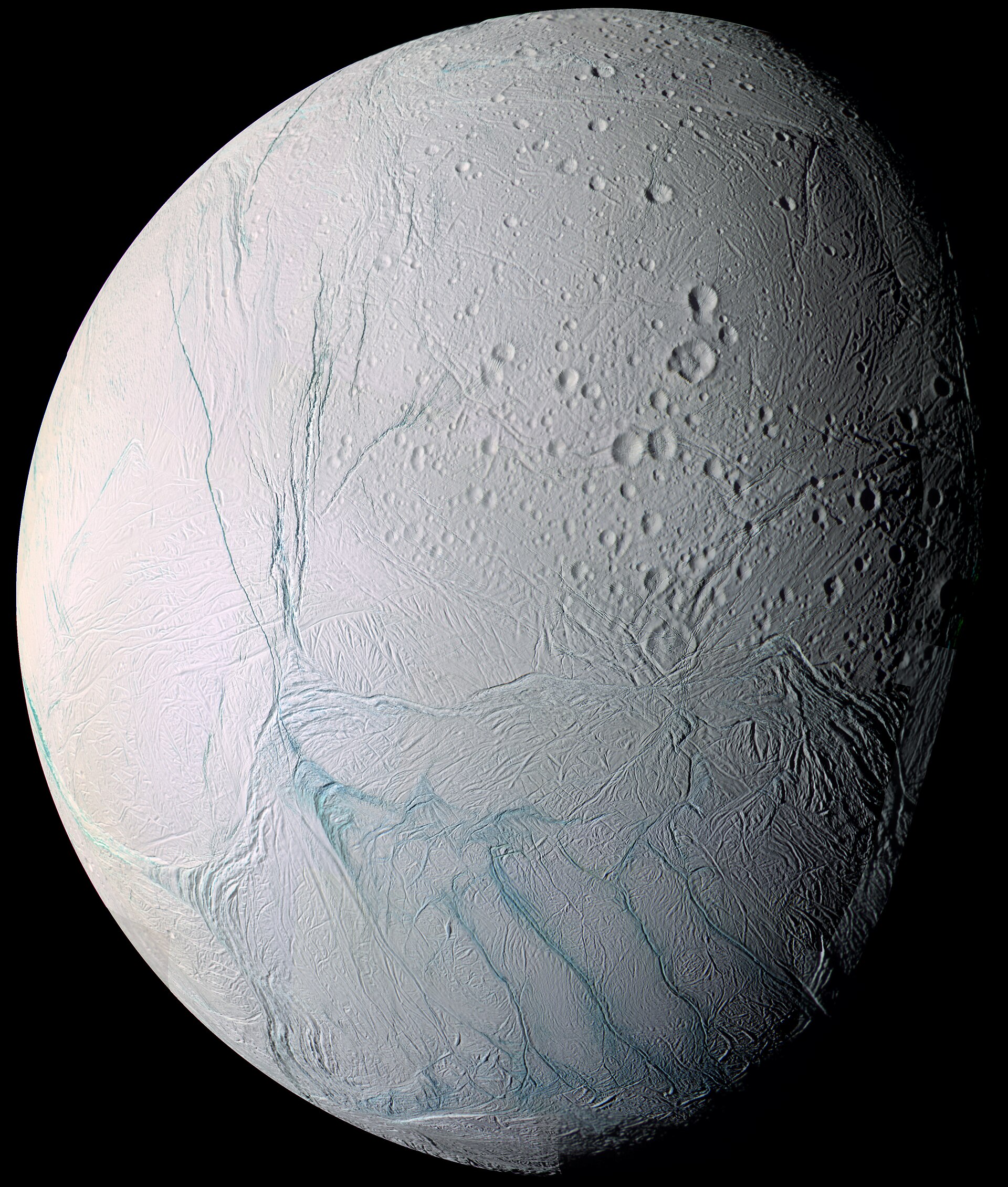
The blue brings up the “tiger stripe” ridges rather well, and these are tectonic features, from the icy surface breaking into “plates”. (That implies another subsurface “ocean” like on Europa and Titan.) Some are canyons 5-10 km wide and a kilometer deep.
Enceladus has a density 1.6 times that of water, so it has a much higher percentage of rocks in it than does Mimas.
At least some volcanoes–well strictly speaking these are geysers–are still active, here’s an oblique shot of the south polar region:
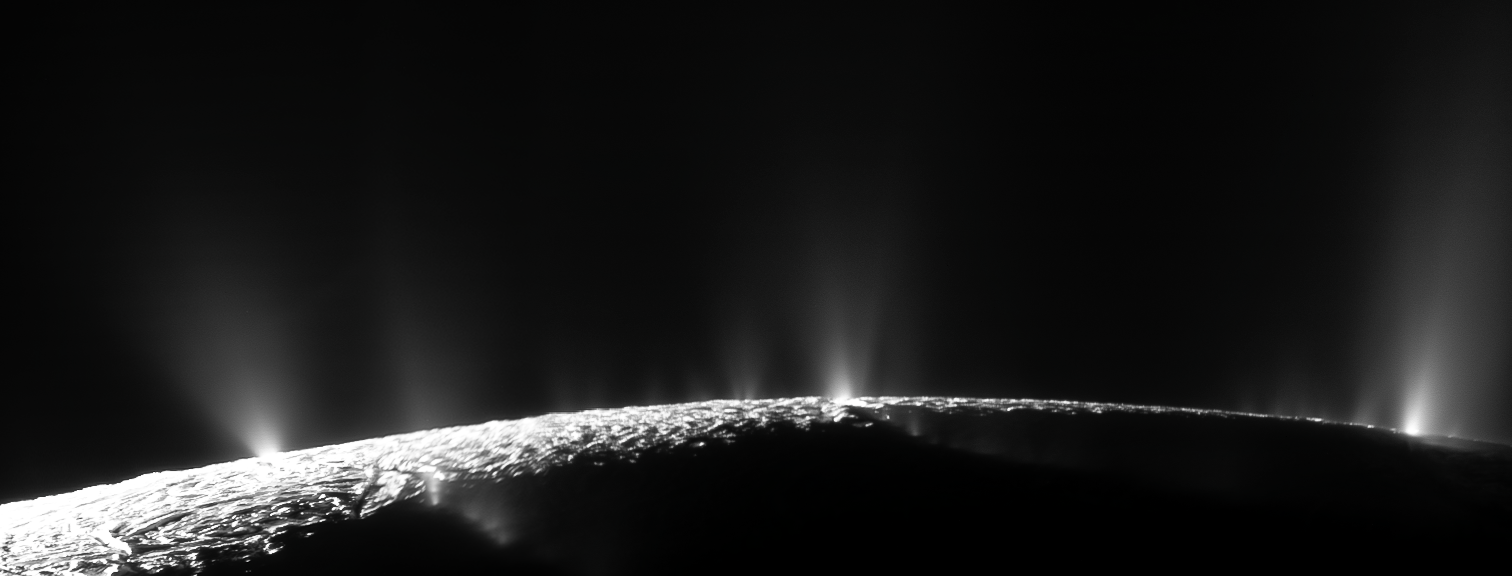
This stuff is coming from the subsurface ocean. And because of that subsurface ocean and evident sources of heat, Enceladus is being thought of as yet another candidate for life to exist.
Cassini nearly didn’t get to see this. On one Enceladus flyby one of the scientists, Professor Michele Dougherty, noticed what she called a “pimple” in the magnetometer readings, caused by moving ionized water. She managed to persuade the JPL Cassini team to change the schedule of flybys to get much closer to Enceladus. (This was a huge risk–if they found nothing, a lot of irreplaceable fuel would be gone for nothing, and perhaps the magnetometer team would not be taken seriously again.) It paid off, bigly: the lead investigator for the camera, Doctor Carolyn Porco, said she nearly fell off her chair when she saw the pictures of the geysers.
This is the only confirmed liquid water in the solar system, other than on Earth.
We have talked of going ice fishing on Europa. But here, there’s no need to drill! We can send a spacecraft through the plumes and analyze the vapor, to perhaps see what’s in the water. Biomolecules? Life?
These volcanoes have been venting so prolifically, in fact, that Enceladus is the primary source of the E ring. (By happy coincidence, Enceladus starts with E, so it’s a good mnemonic.) If you need more evidence:

Tethys
Tethys is another ball of ice, neutral colored and almost as bright as Enceladus. What sets it apart is that its density is 0.98 that of water, indicating it must be almost pure ice…and likely porous to boot.

Although not as obvious as Herschel is on Mimas, there is a large impact crater here too, named Odysseus.

Tethys has two other moons occupying its orbit, one 60 degrees ahead at Lagrange Point 4 (L4), named Telesto, the other 60 degrees behind at Lagrange Point 5 (L5), Calypso. This is actually a special solution to the three body problem, bodies placed at those two points are very stable. Objects like these are called “Trojans”. (Jupiter has thousands of Trojan asteroids.)
Dione
Dione is less icy than Tethys, with a density 1.48 times that of water. For some reason, its trailing hemisphere is darker than its leading hemisphere. (What is a trailing (or leading) hemisphere? Since this moon is tidally locked, it always has the same side facing Saturn; that means it also has the same side “facing” the direction it moves in it’s orbit; that’s the leading hemisphere and the other hemisphere is the trailing hemisphere.)

The trailing hemisphere has “wispy” features seen by the Voyager probes, which turn out to be ice cliffs several hundred meters high. The cliffs are formed by tectonic forces and the bright “wisps” are actually the fresh faces of the cliffs. In fact Dione has a lot of fractures on the trailing hemisphere.
In case you’re thinking I am lying about these gray-white pictures being color images, here’s Dione with Saturn in the background. The sun is shining from below the viewer, and you can see shadows of the rings on Saturn in the upper right.

Dione also has Trojans, Helene (leading) and Polydeuces (trailing).
Rhea
Now we leave the inner moons, and go to the outer regular moons, the ones completely outside the E ring.
Rhea is the second largest moon of Saturn and the second largest “medium size” moon in the Solar System (edged out by Uranus’s Titania), but bear in mind with Titan having 96 percent of the mass of all moons and rings in it, Rhea is a very distant second to Titan.
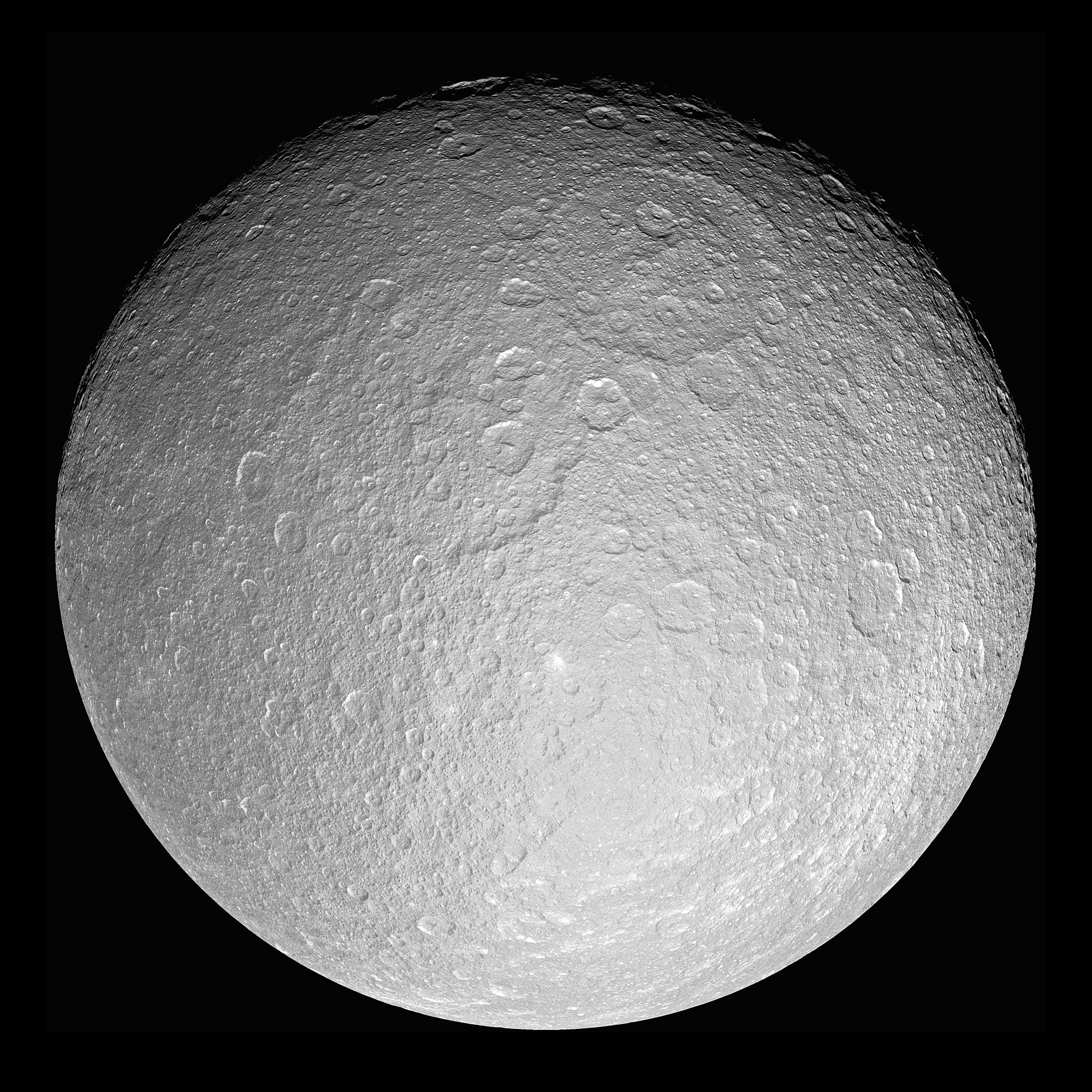
In many ways it’s similar to Dione, perhaps a bit less dense at 1.24 times water, it’s basically 3/4 ice. It has the same leading/trailing distinction, with wispy features that turn out to be cliffs, just like Dione.
Rhea might actually have a ring of its own, a very tenuous one–and that would be a first for a moon. Some indirect evidence (changes in the flow of electrons in Saturn’s magnetic field) points towards it, but Cassini was unable to image it or otherwise confirm it…so it may be necessary to explain that evidence in other ways.
Titan
(Covered last week, but to recap: 5149.5 km across, orbiting at 1,221,900 km in 15.945 days).
Hyperion
Now we come to an oddity. Hyperion is one of the largest objects in the solar system that is not round even though it’s not all that much smaller than Mimas.
When faced with something like this, one asks why Hyperion in particular did not collapse into a sphere. And the reason for that is it’s very light for its size…you could even joke about it being the styrofoam moon. The density is 0.54 times that of water. As such it has only 15% of the mass of Mimas, which is the smallest known body that is made spherical by gravity.
How can this be? Well, take a look:

It looks like a giant sponge! It has a porosity of 0.46 (which makes me wonder how one puts a number on porisity so down a Wikipedia rabbit hole I go and…ah yes, that means it’s 46 percent empty space).
Interestingly, it’s not tidally locked to Saturn. Instead it is chaotically tumbling, rotating around multiple axes at once. This is the only regular satellite in the solar system that is not tidally locked to its primary. (Remember that “regular” satellites are ones in low inclination nearly circular orbits; these tend to be close-in to the primary.) Because its rotation is actually chaotic, it’s very difficult to predict how it’s going to be oriented at some time in the future.
It may not be tidally locked to Saturn, but it is in an orbital resonance with Titan. In the time it takes Titan to orbit Saturn four times, Hyperion orbits three times.
Another thing that makes this moon a change of pace is that it’s not blast white; it seems to be covered by a thin layer of dark material, likely hydrocarbons.
Iapetus
(Pronounced EYE-app-et-us.) Much further out than the others, this is at the edge of the regular moons. This moon is another oddball, a relief after several moons that seem very much alike other than their size. First, its orbital plane is actually inclined by 15 degrees to Saturn’s equator, so from this moon you can actually see the rings tilted rather nicely. Here is an illustration of the situation:

Iapetus is famous for having its leading hemisphere be as dark as coal while its trailing hemisphere is bright, about as bright as Europa. Thus, when its on one side of its orbit (as seen from anywhere far away from Saturn, such as Earth) it’s quite bright, on the other side, it’s quite dark (actually too dark for the telescope that discovered Iapetus), it could almost be thought of as a blinking beacon.

Or, if you’re Arthur C. Clarke, there’s no “almost” about it; it’s a blinking beacon.
We’ve all seen or at least heard of the iconic movie 2001: A Space Odyssey. It was based on Arthur C. Clarke’s (1917-2008) novel of the same name. There is, however, one very big difference between the book and the novel.
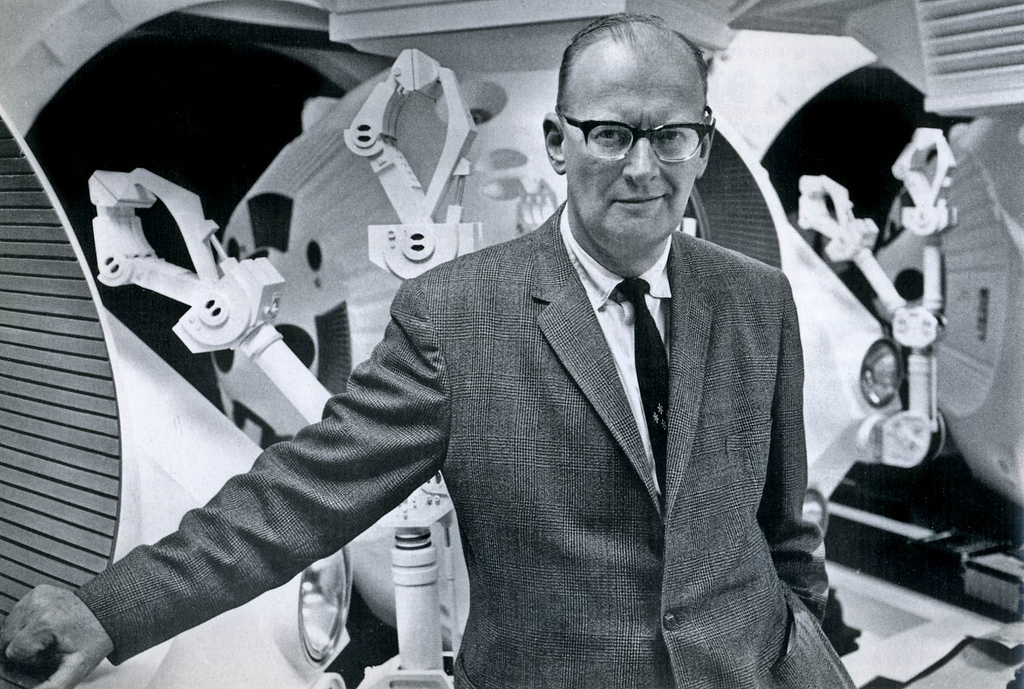
Note that the pod bay door is open. Apparently HAL is willing to open the pod bay door only if it will kill someone to do so. But Clarke seems perfectly able to breathe.
[Possible spoiler]. In the movie, an alien artifact, a “monolith” is excavated on the Moon; when the sun hits the unburied monolith for the first time, it blasts a loud radio signal. The book is the same way; the monolith is “phoning home” telling its makers that someone–presumably a new intelligent species (us!)–has found it.
[More spoiler] The difference is, in the movie the signal is aimed at Jupiter. In the book, it’s aimed at Iapetus, the blinking beacon. In the book, the already scheduled mission to Jupiter is changed…it’s now going to be a one-way trip to Saturn (with a Jupiter flyby), with the astronauts all going into cold sleep at Saturn to await retrieval by the next mission–once they’ve looked around a bit at Iapetus. It turns out that there’s a monolith waiting for them there, right smack dab in the center of a clearly artificial white oval that accounts for Iapetus’ bright side (making it look like a pupil in an eye). In the movie, of course, the Monolith is orbiting Jupiter. The result of getting close to the monolith is the same in both cases. Had they decided to go to Saturn in the movie, you’d have seen some different special effects (Saturn as a crescent, perhaps; that’s mentioned in the book–instead of Jupiter and the Galilean moons).
[Spoiler, this time for the sequel 2010]. When Arthur C. Clarke wrote 2010, the sequel, he decided to make it a sequel to the movie, reasoning more readers were likely to be familiar with it than the book. And this turned out to be lucky because he was able to leverage off the possibility that Europa has life. The 2010 movie leaves out the Chinese probe that was destroyed by Europan life. The hostility in the book was between China and everyone else, not between the US and the Soviet Union (who were fairly friendly to each other). The movie kept all the power of the book, but removed the Chinese subplot of the fatal discovery of life on Europa (it was there anyway) and added in a nasty dash of propagandizing about Reagan’s Central American policies. If you enjoyed the movie I recommend the book.
OK back to Iapetus. The coloring disparity is even more apparent when one makes a map of Iapetus. There’s little detail in the dark areas, because, frankly, we can’t sucking fee that well there:
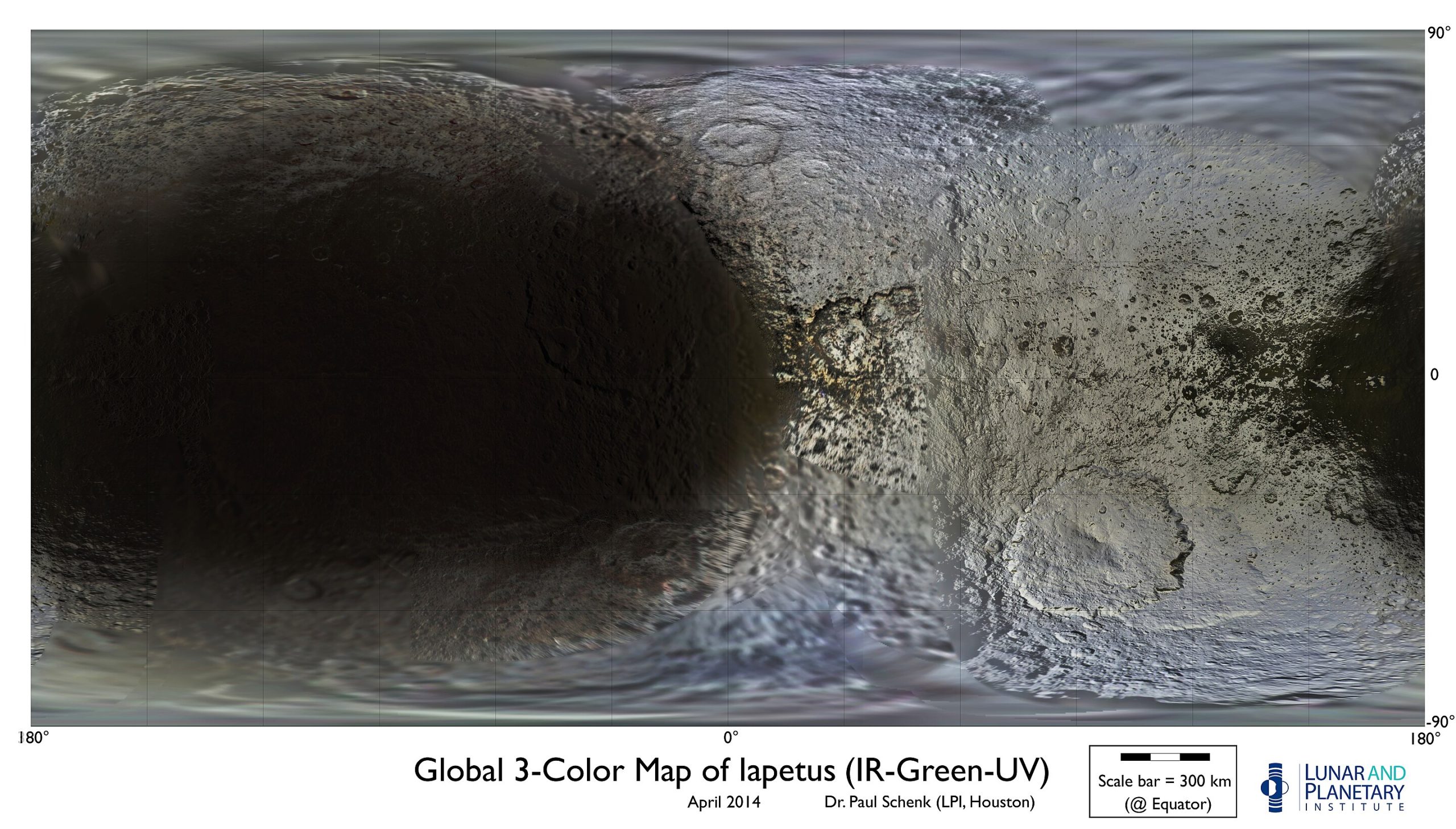
The dark region is named Cassini Regio.
Iapetus has one other unusual feature…a raised ridge running along the equator, now named the Voyager Mountains. This was first hinted at by Voyager, which passed over Iapetus’s north polar regions. The ridge is 20 km or so wide, and 13 km tall (over 50 percent higher than Everest is above sea level). There are peaks that go up as much as 20 km. There are places where it forks, has three parallel areas. However…this ridge is in the dark zone. On the bright side, there is still a string of isolated 10km tall mountains along the equator. Given Iapetus is considerably smaller than Earth, this is a very prominent feature, as you can see here:

But this hypothesis is not tenable as there are no driveways for the ridge to block.
We aren’t clear on why this ridge formed. Nothing suggested explains why it follows the equator so well. And no suggestion explains why it only appears in the Cassini Regio (dark area).
As a final treat, here’s an enhanced picture. On my system at least, I can even see the equatorial ridge on the far right.

Phoebe
This one’s a bonus (though if you’ve made it this far, you might deem it more a case of me prolonging your suffering); it’s not a major moon, it’s not one of those five almost-major moons comparable to the medium-small major moons…it’s an irregular moon, basically trash picked up by the planet. But we’ve known about it for quite some time, and it’s pretty large for a “trash” moon.
Phoebe was actually the first object Cassini flew by. Cassini’s arrival was deliberately timed so that it would be able to encounter this irregular moon, but of course once in orbit about Saturn it never came out this far ever again. But that does make Phoebe the best-known irregular moon.

Phoebe orbits “backwards” or retrograde (the second largest object in the Solar System to do so), so it’s thought to be a captured asteroid like object, only from the outer parts of the Solar System, the Kuiper belt (we’ll get to those). It’s also in a highly inclined orbit. Here is an animation (note the faint lines showing distance above and below Saturn’s equatorial plane). The light blue object is Titan.

Phoebe appears to be differentiated (denser stuff in the center) so it’s possible it was once spherical and got warped by repeated impacts.
It’s much too far away from Saturn to have become tidally locked, and isn’t. It rotates in nine hours and 16 minutes, rather than once every 18 months as it would if it were tidally locked.
Phoebe is the source of the “Phoebe ring,” a very tenuous ring of debris about Saturn, thought to be the result of stuff blown off of Phoebe by meteoroid impacts. The ring matches Phoebe’s orbit, so it is inclined to Saturn’s other rings. Here is an artist’s illustration (note they had to blow up Saturn).

Phoebe has the distinction of being used as the alien weapon in the recent SF series The Expanse.
Well, that’s all. folks! Saturn has the most major moons of any of the planets or even dwarf planets…so from here on out things should get a little bit easier, at least so long as we are looking at planets. (It will also help that we’ve flown past everything from here on out exactly once and never sent an orbiter–so we know next to nothing about anything out there.)
I’ll conclude with pictures of Giovanni Domenico Cassini (8 June 1625 – 14 September 1712), discoverer of four moons and the Cassini division in the rings…

and Christiaan Huygens, 14 April 1629 – 8 July 1695, discoverer of Titan and the first to realize Saturn had rings. (The original Dutch pronunciation is [ˈkrɪstijaːn ˈɦœyɣə(n)s] [sound file of pronunciation] which just goes to prove the Dutch adage that Dutch isn’t a language it is a throat condition.)

The next planet out is Uranus, but I’ve already done the planet (the Hugh Janus of the Solar System: https://www.theqtree.com/2023/12/30/2023%C2%B712%C2%B730-joe-biden-didnt-win-daily-thread/) so after a short recap (because our wits are all dulled from listening to Kamaltoe Hairyass for the last few months), we can go directly to Uranus’s bevy of medium and medium-small moons next time.


